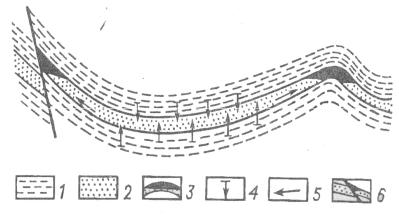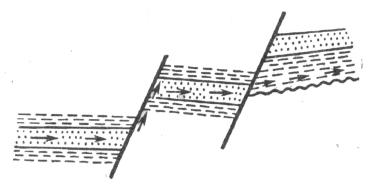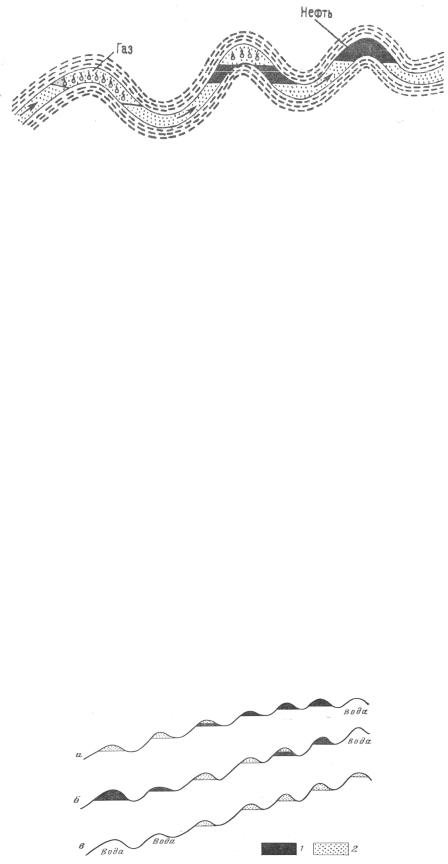
книги / Геология нефти и газа
..pdfThus, porosity factor, oiland gas saturation factors are determined. These factors are used for calculating the HC reserves. Permeability coefficient required for design of field development is also determined.
CHANGE OF RESERVOIR PROPERTIES AT VARIOUS DEPTHS
Since it is necessary to conduct deep development, at present, of special attention is study of regularities of changes reservoir properties of rocks at depths over 5 000 m. As the depth of occurrence of reservoir rocks increases, their density is also increased under geostatic pressure, and, subsequently, porosity is decreased and permeability is worsened. However, at some intervals of depths, the reservoir properties are retained, and sometimes are even improved.
1.In response to tectonic stresses, the reservoir properties of carbonate rocks are improved due to creating the secondary porosity (dissolved carbonaceous cement, fracturing and so on).
Fissuring of carbonate deposits occurs at fault-angle structures and during hydraulic fracturing.
2.The secondary porosity in terrigeneous rocks at large depths appears due to leaching or dissolving carbonaceous – argillaceous cement under action of hot water saturated with carbon dioxide.
Thus, decrease of reservoir storage capacity at large depths in compensated by fracturing and secondary pores and caverns.
CAP ROCK (SEALS) (IMPERMEABLE BED).
When determining conditions of oil and gas accumulation conditions, it is necessary also to determine that in addition to the reservoir rocks, gas-oil impermeable cap rocks (seals) presented by clays, argillites and evaporites (salts, plaster-stones and anhydrates) play an important role in forming and maintaining the natural reservoirs. Clayey silt and clayey limestone and other can also serve as cap.
The screening capacity of caps is impacted by occurrence (length), thickness, composition, homogeneity tectonic deformation, depth of occurrence and other. For instance, property of clay cap rocks is worsened, and screening capacities of salt cap rocks are improved (plastic property of salts at large depths is high).
E.A. Bakirov proposed the below classification of impermeable beds.
1.Regional impermeable beds. These are impermeable rock masses occurred within the entire territory of petroleum province (Western Siberia petroleum province).
2.Subregional impermeable beds. These are impermeable rock masses which are confined to with petroleum regions (Turonian clays in Western Siberia petroleum province).
81

3.Zonal impermeable beds. These are impermeable rock masses, occurrence of which is restricted by petroleum accumulation zone (Kungurian deposits in the Caspian depression).
4.Local impermeable beds. These are impermeable rock masses which seal a local structure (Maikopian clays of the Zhuravskoye field).
By lithological composition, cap rocks are subdivided into:
1.homogeneous cap rocks, which consist of rock of one lithological composition (clayey); and
2.heterogeneous cap rocks, which consist of rocks of various lithological composition (clayey-salt).
Lecture 4
NATURAL RESERVOIRS AND TRAPS
Natural reservoirs and traps are intimately connected notions as trap is a part of reservoir.
Natural reservoir is a natural oil and gas container inside which circulation of fluids is possible. Fluid is oil, gas and water in rocks. Morphology of natural reservoir depends on the ratio of horizontal and vertical senses of the reservoir to the low permeable rocks that contained them.
There are three main types of the natural reservoirs: formation reservoirs, massive reservoirs and lithologically screened reservoirs.
FORMATION RESERVOIR
Formation reservoir is a complex of permeable reservoir rocks bounded by impermeable rocks at the top and bottom.
The formation reservoirs are characterized by the following:
1.They occur in terrigeneous and carbonate rocks.
2.They are well persistent in lithology and thickness within large areas of petroleum (oil-and-gas bearing) regions.
3.The reservoir rocks are characterized by small thickness (up to several tens of meters).
Fig. 6
82
MASSIVE RESERVOIR
Formation reservoir is a complex of permeable reservoir rocks bounded, unlike the formation reservoirs, by impermeable rocks only at the top.
The massive reservoirs are characterized by the following:
1.They are very thick (several hundreds of meters).
2.In terms of lithology they are subdivided into:
–homogeneous – massive reservoirs. They occur in carbonate deposits (limestone and dolomites); and
–heterogeneous – massive reservoirs. They are formed by carbonate and terrigeneous rocks.
LITHOLOGICALLY SCREENED RESERVOIR
Permeable screened reservoir rocks surrounded on all sides (locked) by low permeable rocks relate to the lithologically screened reservoirs. For instance, sand packages – lenses.
Very often reservoirs can be related both to the formation reservoirs and to the massive reservoirs. Such reservoirs (formation-massive) within particular part of the section have properties of the formation reservoirs, though they are massive as a whole, i.e. are an unified hydrodynamic system, in consequence of which WOC and GOC are at one the same hypsometric point. Thickness of oil and gas accumulation is fair large in such reservoirs.
NATURAL OIL AND GAS TRAPS
Trap is a part of the natural reservoir. It is characterized by conditions that promote generating and retaining oil and gas accumulations (pools).
Oil and gas are lighter than water, and they move in water both vertically and horizontally until they reach impermeable rocks. The basic principles of migration are pressure difference and gravitational floating up of oil and gas in water.
The role of trap can be played by:
1.dome parts of positive structures;
2.stratigraphic unconformity areas;
3.lithologic thinning-out areas.
4.porosity and permeability local change areas; and
5.tectonically screened parts of structures.
Based on the reasons that cause forming traps, there are the following types of traps:
1.Structural Traps (anticline traps).
2.Stratigraphic Traps.
3.Lithologically Screened Traps.
83

STRUCTURAL TRAPS
The below types of structural traps are of commercial significance:
1.Dome traps and
2.Tectonically screened traps.
Dome Traps
Hydrocarbons arrive at trap by migrating in reservoirs along bed rise or perpendicular to their stratum on tectonic deformation, i.e. domes of anticline structures, in which they form commercial accumulation of oil and gas.
Often the dome traps are termed anticline traps, and all the rest traps – non-anticline traps.
Tectonically Screened Traps
Such traps occur in folded regions and domed salt areas.
Fig. 7
STRATIGRAPHIC TRAPS
The below structures can be termed as stratigraphic traps:
1. Reef masses in which oil and gas are accumulated in porous limestones overlapped by low permeable rocks (plaster-rocks, anhydrites and other).
Fig. 8
84

2. Stratigraphic traps are formed at overlap of head parts of reservoir rocks undermined by impermeable rocks. The surface that separates these strata from the earlier formed strata is termed the surface of stratigraphic unconformity.
Fig. 9
LITHOLOGICALLY SCREENED TRAPS
Lithologically screened traps are formed due to:
1.lithologic variation in reservoir rocks;
2.pinching out sands and sandstone along bed rise;
3.reservoir porosity and permeability changing; and
4.rock-scale fracturing.
Fig. 10
Traps can be combined or complex, i.e. their formation is caused by various factors.
85

Lecture 5
OIL AND GAS MIGRATION
Migration of oil and gas is all their movements in the Earth’s crust. The main factors of oil and gas migration are gravity, pressure gradients, temperature and concentration of hydrocarbons.
Role and impact force of the above listed factors depend on the particular properties of geological space and duration of their impact. There are primary and secondary migration:
1.Primary migration is a process of hydrocarbon migration from source rocks to reservoir rocks.
2.Secondary migration is migration of hydrocarbons in reservoir rocks, disjunctive dislocation, fractures, stratigraphic unconformity surfaces and so on (fig. 11).
Fig. 11
The basic property of geologic environment that provides oil and gas migration is heterogeneity of porosity, permeability and structural-tectonic conditions. Migration conditions depends on lithological and tectonic conditions which affect the ways of oil and gas migration and places of accumulation.
Migration takes place in the proper least flow coefficient sense, i.e. in direction of the bed rise in its top part through the rocks with highest permeability up to tectonic or lithologic screen. Such migration is termed secondary (intrastratal) migration.
Inter-reservoir (interstratal) migration is a migration of oil and gas along disjunctive dislocations or stratigraphic unconformities (discordances).
OIL AND GAS FIELDS
Oil and gas field consists of one or more oil and gas pools within bounded area which are genetically interconnected and originated due to common geological factors. Notions the “field” and the “pool” are interconnected. As it is well known there single play and multiplay fields. In the first case the field and pool are synonyms.
Fields differ in fluid content and composition.
86

In 1961, I.A. Eremeenko said that “tectonic characteristics of this or that structural element that controls forming of field, first of all, depends on with what large geostructural elements of the Earth’s crust the formation of the given element is associated”. Based on the above, there are two basic classes of fields:
1.Folded region fields; and
2.Platform fields.
By amount of oil reserves (mln tons) and gas (bln m3), the fields are subdivided into small (size) – less than 10 mln tons of oil or less than 10 bln m3 of gas, medium (size) – 10–30 mln tons of oil or 10–30 bln m3 of gas, large (size) – 30–300 mln tons of oil or 30–500 bln m3 of gas, unique – more than 300 mln tons of oil or more than 500 bln m3 of gas [3].
Lecture 6
OIL AND GAS ACCUMULATIONS
FORMATION OF OIL AND GAS ACCUMULATIONS
The fundamental processes of oil and gas accumulations are interconnected processes of migration, differentiation and accumulation of hydrocarbons. Filling up traps, fluid phase and composition of hydrocarbons depend on these processes. According to A.A. Bakirov, there are primary reservoirs which are within the source rocks, and secondary reservoirs which are beyond the source rocks. Consequently, intrastratal (lateral) migration plays the key role in forming of primary reservoirs, and interstratal (vertical) secondary reservoirs.
In nature, accumulations are formed due to combining of various types of migration. Accumulations can be formed stepwise by combined horizontal and vertical migration.
Fig. 12
One of the main, though presumably not all-pervading, explanation of peculiarities of trap filling is the principle of differential trapping of oil and gas that was put forward by S.P. Maksimov, V.P. Savchenko and V. Gasso. It is based on the capability of gas to migrate faster than oil, replace and displace oil from the overfilled trap, i.e. gas accumulations are replaced with gas-and-oil and oil accumulations as hypsometric points of traps are risen.
87

Oil and gas accumulations are located according to the principle of differential trapping only in case if HC migrate in a free state in the form of oil and gas currents.
Fig. 13
A completely different type of situation occurs if HC migrate in a dissolved state. If hydrocarbons migrate in dissolved state along regional bed rise, pressure and temperature decrease promotes transforming oil and gas in a free state. As solubility of liquid HC is lower than that of gaseous HC, first, oil transforms from the dissolved state, and fills the first hypsometrically lowest trap. In further, as dissolved HC migrate upward along bed rise, gaseous HC are evolved together with liquid HC, and that is why oil and gas are accumulated in the next traps, and higher – only gas. Such differentiation of HC takes place under the principle of gravity segregation of fluids.
Upon a whole, type of accumulation, its fluid state and HC composition depend on features of regional geological structure and development. Despite the great theoretical interest and practical significance, time and duration of formation of oil and gas accumulations are ones of the most discussible issues of Oil and Gas (Petroleum) Geology.
Some scientists consider that oil accumulations are formed directly after depositing of reservoir rocks. According to other scientists, there is a long time period between these processes. And there are scientists who believe that oil and gas accumulations have been formed in relatively recent geological age.
Moreover, sometimes oil and gas formation is related to the particular stages of geological evolution. In this connection, we can note that time of formation of oil and gas accumulations depends on geological features and history of evolution of particular regions, which greatly differ for each of them.
Fig. 14
88

CLASSIFICATION OF OIL AND GAS POOLS
Pool is a natural local accumulation of oil and gas that occupies a part (trap) of natural reservoir. If pool development us economically feasible, it is termed as commercial pool.
It is necessary to consider that pools differ in fluid content and composition (pure oil, pure gas and combined pools, i.e. two fluids: oil pool with gas cap and gas pool with oil fringe (leg), and gas condensate pools).
There are simple and complex (sandwich-type, multi-cap and other) pools.
Fig. 15
Fig. 16
89

It is advisable to take a classification proposed by A.A. Bakirov (1960), who by developing I.M. Gubkin concepts, identified four main classes of local oil and gas pools: structural pool, lithological pool, reef pool and stratigraphic pool.
When studying this section, it is necessary to get knowledge sufficient for identifying genetic type of pool, determining by geological documentation and diagrammatic layout such elements of pool as height, length, width and area of pool, vertical closure of trap, water-oil contact (WOC), gas-oil contact (GOC), gas-water contact (GWC), outer and inner oil pool (gas pool) outlines and so on.
Classification of Oil and Gas Pools
Классификация залежей нефти и газа (по А. А. Бакирову)
Класс |
Группа |
Подгруппа |
Структурные |
Залежи |
Сводовые |
|
антиклинальных |
Тектонически экранированные |
|
структур |
Приконтактные |
|
|
Висячие |
|
Залежи |
Экранированные разрывными нарушениями |
|
моноклиналей |
Связанные с флексурными образованиями |
|
|
Связанные со структурными носами |
|
Залежи |
|
|
синклинальных |
|
|
структур |
|
Рифогенные |
Связанные |
|
|
с рифовыми массивами |
|
Литологические |
Литологически |
Приуроченные к участкам выклинивания |
|
экранированные |
коллекторов |
|
|
Приуроченные к участкам замещения |
|
|
проницаемых пород непроницаемыми |
|
|
Экранированные асфальтом или битумом |
|
Литологически |
Приуроченные к песчаным образованиям |
|
ограниченные |
русел палеорек (шнурковые |
|
|
или рукавообразные) |
|
|
Приуроченные к прибрежно-песчаным |
|
|
валоподобным образованиям |
|
|
ископаемых баров |
|
|
Линзовидные (Гнездовидные) |
Страти- |
Залежи в коллекторах |
Связанные со стратиграфическими |
графические |
срезанных эрозией |
несогласиями на тектонических структурах |
|
и перекрытых |
Связанные со стратиграфическими |
|
непроницаемыми |
несогласиями, приуроченными |
|
породами |
к эродированной поверхности погребенных |
|
|
останцев палеорельефа или выступов |
|
|
кристаллического фундамента |
90
